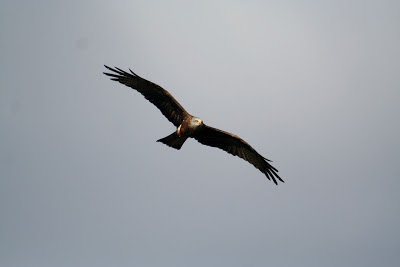Dawn breaks over the cold beach at Great Yarmouth. The sun’s rays splintering between
broken clouds, the lights of the sea front buildings twinkle in the remaining
darkness that slowly fills with diffuse morning light. The sand shifts under
foot as the group makes its way, laden with gear, to the tide line. Warm breath
steaming in the cold air, slowly a large net is stretched out and then furled
into a shallow trench in the sand. Canons are buried and the net
attached. A long blue cable is wheeled out to a safe distance where a box with
switches and buttons reminiscent of a space station sits in the sand. The group
disperses to wait. Bait in the form of soaked bread is scattered into the
catching area, with dry bits flung into the air in order to attract our quarry.
Gulls. But not just any gulls, Mediterranean Gulls.
 |
| A beautiful adult Mediterranean Gull |
Back in August 2012 a Wild Barley post called The Med in Norfolk discussed the sighting
of colour ringed Mediterranean Gulls sighted from this very beach in Great Yarmouth. From such sightings
we know that birds ringed in Belgium, the Netherlands and Germany regularly cross the
North Sea and spend the winter on our shores. But not all birds on the beach are colour ringed. What about
the others? Are they all coming from these countries or from other locations
throughout Europe? Do all the birds wintering in Great Yarmouth return to the same
places? Now a group
of ringers, and birders who regularly come to Great Yarmouth to read the rings
of gulls on the beach, are embarking on a new project in order to find out.
The morning
progresses; the sea front comes to life with dog walkers and workers making their way to offices, shops, cafes and bars throughout the town which at this time of year is sleepy and quiet. The birds sit in groups away down the beach, occasionally one shows
a brief interest in our offering. We wait, and wait. Catching birds in this
way, using a canon to fire a net over the top of the birds is not undertaken
lightly. Ringers undergo rigorous and lengthy training in order to obtain this
licence.
Suddenly
there is a loud ‘bang’ and without even looking up the team starts sprinting across the
sand to the birds now trapped under the net. Legs pumping, straining against
the sand, the runners arrive (yes definitely out of breath) at the net,
preventing birds from escaping and starting to remove them from beneath the mesh.
 |
| The canon net fires over the group of gulls trapping them beneath © David Pelling |
Each bird is
bagged, and then ringed with a uniquely numbered metal ring as well as a
plastic alpha-numeric colour ring. The birds are aged, their wings measured and they are weighed before being released back along the beach.
A success! The catch has 13 new Mediterranean Gulls with a variety of different aged birds;
adults with their clean grey backs, brilliant white wings, deep red bill and
legs and smudge of black around the head; a second year bird with remnants of
black in the wing feathers; and first year birds, those that have been born
this year, with brown feathers scattered amongst the grey of the wings and back.
 |
The three ages of Mediterranean Gull;
first year, second year and adult (left to right) © David Pelling |
In addition to these there are three birds with rings on already, all of which
herald from Belgium.
Once all the
birds are processed and released, the net is set again, and after a cup of steaming
hot chocolate to warm the cockles and the fingers, the wait begins again in the
hope of a second catch. Almost at the point of accepting one catch for the day, the
net is once again fired and once again the team races across the sand to collect
the birds. A smaller catch this time, but still another two Mediterranean Gulls ringed and
added to the total for this, the projects inaugural catch.




































